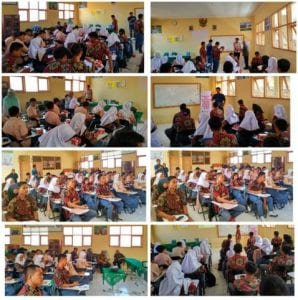TELEMATIC RESEARCH GROUP COMMUNITY SERVICE AT PUBLIC VOCATIONAL SCHOOL 1 CILENGKRANG BANDUNG REGENCY
“UTILIZATION OF INTERNET OF THINGS FOR URBAN FARMING”

Urban farming is one of the methods of Non-Conventional Agriculture in Urban areas. Urban farming becomes one of the alternative solutions for Urban Communities who want to grow crops in a limited area, which is the main obstacle in Urban areas. Not only limited areas, but urban farming can also be a solution for farmers who have uneven land contours and inadequate irrigation facilities.
Public Vocational School 1 Cilengkrang Bandung Regency located in the middle of the rugged contour land (hills). The school has several scientific majors, one of which is the Agriculture Study Program. The Agricultural Model used in the teaching and learning process still uses the Conventional Method, which is Farming in the Garden Area. The Department of Agriculture is a major that has not been much in demand. So, there is a need for technological breakthroughs to make teaching and learning activities related to Agriculture more exciting and can also be in line with Technological Development.
In the Community Service Activities of the Telematics Research Group with the Topic of Utilizing the Internet of Things (IoT) for Urban Farming, an Introduction to Information Technology has been carried out, in this case, the introduction of IoT Technology for Agriculture. This activity was carried out by several lecturers from the Telematics Research Group to introduce Agriculture in this case suitable for non-conventional methods, such as Viticulture, Hydroponics, and Aquaponics. One of the IoT Applications for Agriculture was also introduced namely Smart Farming.
Hopefully, this Community Service Activity can provide Awareness and Additional Methods for Conventional Agriculture. The existing method, “enriched” with various devices connected to the Internet for ease of monitoring aspects, such as monitoring the level of soil moisture, air temperature, light intensity, and plant nutrition.
The feedback generated from this activity included that this activity was exciting and substantially opened students’ and teachers’ insights regarding information technology applied in agriculture. Besides, the material presented is essential so that students can use IoT in their learning activities and prove that IoT can increase agricultural productivity. As many as 90% of these activities are following the objectives and needs of the participants. And 100% of participants expect this activity to continue in the future for the next topics.
As for the footage on community service activities at Public Vocational School 1 Cilengkrang, the following video can be seen.
-ADR-